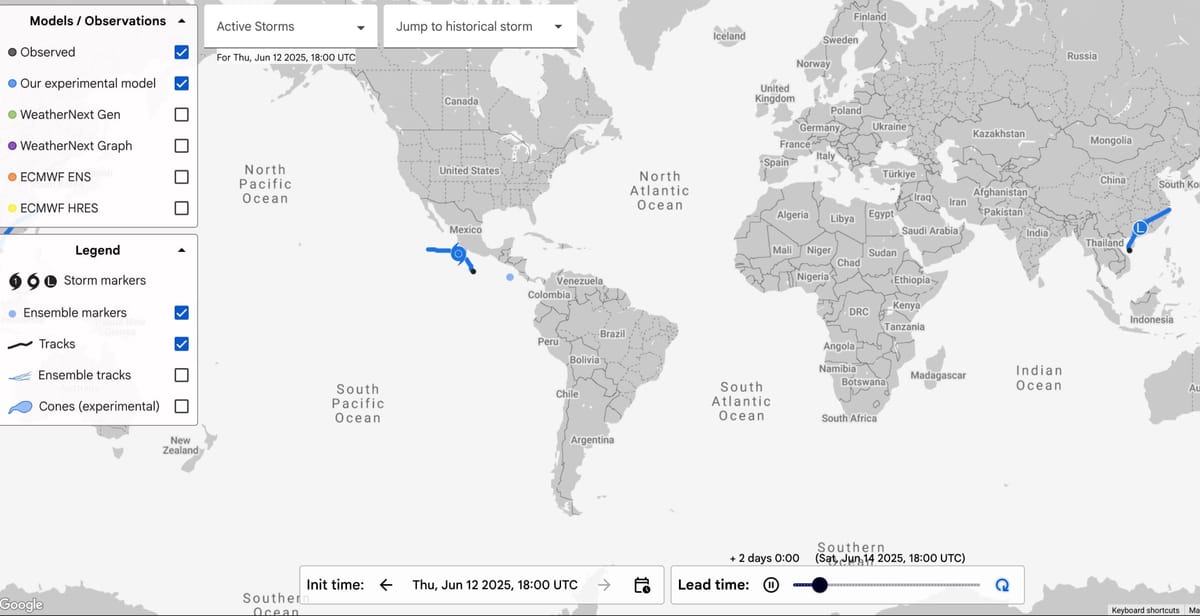
Google DeepMind just dropped what might be the biggest breakthrough in hurricane prediction in decades. The company's new AI system can forecast where hurricanes will form and track their likely paths up to 15 days in advance — and for the first time ever, the U.S. National Hurricane Center is actually using these experimental AI predictions alongside their traditional forecasting models.
The announcement comes with perfect timing as the 2025 Atlantic hurricane season gets underway, with forecasters predicting an above-average year for storm activity. But this isn't just another tech demo — it's a fundamental shift in how we might predict nature's most destructive storms.
Key Points:
- Google's AI model can generate 50 different hurricane scenarios up to 15 days ahead, compared to current models that typically provide 3-5 day forecasts
- The AI achieved a 1.5-day improvement in prediction accuracy — equivalent to about a decade's worth of traditional forecasting progress
- The National Hurricane Center is now using these AI predictions alongside physics-based models for the first time in its operational workflow
The problem with predicting hurricanes
Here's the thing about hurricane forecasting: it's brutally difficult. These vast, rotating storms are very sensitive to even small differences in atmospheric conditions, making them notoriously difficult to forecast accurately. Current physics-based models face a fundamental trade-off problem — they can either predict where a storm will go pretty well, or how strong it'll get, but not both with equal accuracy.
One of the biggest challenges for hurricane modeling is creating a model that can accurately depict the large-scale, environmental flow of the atmosphere that is largely responsible for steering the hurricane, while at the same time representing the finer scale details of the inner core region that determine the intensity of the storm.
The stakes couldn't be higher. In the past 50 years, tropical cyclones have caused $1.4 trillion in economic losses, and throughout US weather history, hurricanes have consistently been the deadliest and most destructive natural disasters.
Enter AI
Instead of trying to solve complex physics equations in real-time, Google's AI model learns from decades of historical storm data. The system is trained on two distinct types of data: a vast reanalysis dataset that reconstructs past weather over the entire Earth from millions of observations, and a specialized database containing key information about the track, intensity, size and wind radii of nearly 5,000 observed cyclones from the past 45 years.
The results are pretty impressive. Google's initial evaluations showed that their model's 5-day cyclone track prediction is, on average, 140 km closer to the true cyclone location than ENS — the leading global physics-based ensemble model from ECMWF. This is comparable to the accuracy of ENS's 3.5-day predictions — a 1.5-day improvement that has typically taken over a decade to achieve.
To put that in perspective: gaining 1.5 days of accurate hurricane prediction time is massive. That's potentially the difference between a chaotic last-minute evacuation and an orderly, well-planned one.
Weather Lab goes live
The new system is available through Google's Weather Lab, an interactive website that lets you see AI storm predictions alongside traditional physics-based models. The first available model can predict where cyclones will form, and their likely path, up to 15 days in advance. The model can also forecast cyclone intensity, size, and structure.
But Google stresses that the Weather Lab predictions are not official weather reports or warnings. They are generated by models still under development and are not official warnings. The company repeatedly emphasizes that people should still rely on official meteorological agencies for authoritative forecasts.
The real validation comes from the pros. Dr. Kate Musgrave, a CIRA Research Scientist, and her team evaluated Google's model and found it to have "comparable or greater skill than the best operational models for track and intensity". She's looking forward to seeing how it performs during the 2025 hurricane season.
The Hurricane Center gets experimental
Perhaps the biggest news is that NHC expert forecasters are now seeing live predictions from Google's experimental AI models, alongside other physics-based models and observations. This marks the first time the federal agency will incorporate experimental AI predictions into its operational forecasting workflow.
"We are presenting three different things," said Ferran Alet, a DeepMind research scientist leading the project. The collaboration represents a major shift for an agency that has traditionally relied on physics-based numerical weather prediction models.
The broader AI weather revolution
Google's hurricane model is part of a larger AI weather revolution that's been building for years. The company previously released GraphCast, which can predict weather conditions up to 10 days in advance more accurately and much faster than the industry gold-standard weather simulation system. That model famously accurately predicted about nine days in advance that Hurricane Lee would make landfall in Nova Scotia, while traditional forecasts had greater variability and only locked in on Nova Scotia about six days in advance.
Other AI models have shown similar promise. A European AI model called AIFS recently stunned meteorologists by predicting Hurricane Milton's landfall within 7 miles on average—outperforming traditional models by almost 100 miles.
Still, there are many caveats to keep in mind. AI models can’t yet ingest the ragged stew of satellite winds, dropsonde data, and buoy readings the way NWP systems do, and critics argue they still struggle with the “butterfly effect” intrinsic to weather. Even Google warns that, without human oversight, its pretty spaghetti could be dangerously wrong. And with climate-warmed oceans juicing storms in new ways, yesterday’s training data may not describe tomorrow’s cyclones.
What's next
The timing couldn't be better for testing Google's system. Hurricane season in the Atlantic basin began on June 1, with leading hurricane researchers maintaining their forecast for an above-average 2025 Atlantic hurricane season.
FOX Weather Hurricane Specialist Bryan Norcross, who served as an advisor to the Google team, called it "the first hurricane season where we're going to really see what AI can do by this development of a tropical storm- and hurricane-specific AI model".
The real test will come when the next major hurricane forms. Google's AI will be running alongside traditional models, generating its 50 different scenarios, while hurricane specialists at the National Hurricane Center weigh all the available data to make their official forecasts.
Over the past 20 years, one- to three-day track forecast errors have been reduced by about 75%, and four-day and five-day track forecast errors have fallen by 60%. If Google's AI delivers on its promise, we might be looking at another major leap forward in our ability to predict these deadly storms — and that could save countless lives and billions of dollars in damage.
The weather, as they say, affects us all. Now we might finally have the AI tools to predict it better than ever before.

